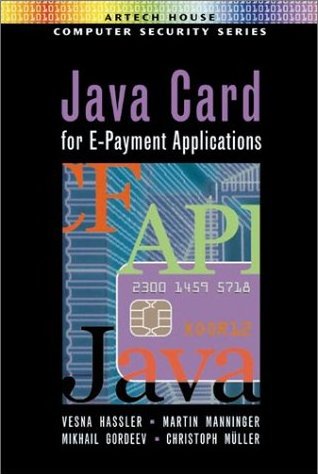| Vesna Hassler, Michail Gordeev, Martin Manninger, Christoph Müller:
Java Card for E-Payment Applications, Artech House, 2001, ISBN 1-58053-291-8
|

|
ContentPreface Chapter 1 Smart Card Basics 1.1 Logic of Integrated Circuit Cards 1.2 Communication Interface of Integrated Circuit Cards 1.3 Smart Card Operating Systems 1.4 Smart Card Life Cycle 1.5 Integrated Circuit Card Standards Chapter 2 Security Issues 2.1 Symmetric Cryptography 2.2 Asymmetric Cryptography 2.3 Authentication 2.4 Smart Card Security 2.5 Known Attacks on Smart Cards 2.6 System Security 2.7 Security Evaluation Criteria 2.7.1 Common Criteria Chapter 3 File structure and commands 3.1 File structure of integrated circuit cards 3.2 Command Structure of Integrated Circuit Cards 3.3 Examples of Smart Card Commands 3.4 Cryptographic Authentication and Secure Messaging Chapter 4 ISO 7816 Smart Card Communication 4.1 Answer to Reset 4.2 T = 1 Chapter 5 Card readers and card terminals Chapter 6 Related technologies Chapter 7 Debit and credit cards 7.1 Relevant Specifications 7.2 EMV Transaction 7.3 EMV 2000 Details 7.3.1 EMV Book 1 7.3.2 EMV Book 2 7.3.3 EMV Book 3 7.3.4 Book 4 Chapter 8 Java Card Basics 8.1 Java Card Architecture 8.2 Differences from Java 8.2.1 Primitive Data Types and Arrays 8.2.2 Operations and Type Casting 8.2.3 Exceptions 8.3 Java Card Applet 8.3.1 Installation and Registration 8.3.2 Selection and Deselection 8.3.3 APDU Processing 8.4 References Chapter 9 Deployment of Java Card Technology 9.1 Java Card Forum 9.1.1 Card Management 9.2 SIM Application Toolkit 9.3 Visa Open Platform 9.4 References Chapter 10 Java Card Security 10.1 Java Card Language Subset Security 10.1.1 Java Safety 10.1.2 Java type safety 10.1.3 Transient Objects 10.1.4 Atomicity of Transactions 10.2 Card Applet Security Mechanisms 10.2.1 Card Applet Firewall 10.2.2 Secure Object Sharing 10.3 Java Card Crypto APIs 10.3.1 PIN Verification 10.4 References Chapter 11 Application Development 11.1 Java Card API 11.1.1 JCSystem Class 11.1.2 Class Applet 11.1.3 APDU Class 11.1.4 OwnerPIN Class 11.1.5 Util Class 11.1.6 Interface ISO7816 11.2 Existing Implementations 11.2.1 Giesecke&Devrient Sm@rtCafé 11.2.2 Gemplus GemXpresso 211 11.2.3 Schlumberger Cyberflex Access Chapter 12 OCF Basics 12.1 Smart Card Applications 12.2 The OpenCard Framework 12.3 The OpenCard Consortium 12.4 OCF Architecture Overview 12.4.1 What is a Framework? 12.4.2 What is an Abstract Factory? 12.4.3 Singleton and Registry 12.5 PC/SC 12.6 OCF versus PC/SC 12.6.1 Platform 12.6.2 Operating System 12.6.3 Terminal Application 12.6.4 Programming Language 12.6.5 Architecture 12.6.6 Interoperability 12.6.7 Java Card and Windows for SmartCard 12.7 Other Card Terminal APIs Chapter 13 OCF structure 13.1 OCF Card Terminal Layer 13.1.1 The Core Part of the Card Terminal Layer 13.1.2 The Optional Part of the Card Terminal Layer 13.2 OCF Card Service Layer 13.2.1 The Core Part of the Card Service Layer 13.2.2 The Optional Part of the Card Service Layer 13.2.3 Standard Card Service Interfaces 13.3 OCF Security 13.4 OCF-Card Terminal Communication 13.5 OCF and Java Card Applets Chapter 14 Case Study Overview 14.1 Sample Application Functionality 14.1.1 Application Architecture 14.1.2 Transaction Flow 14.1.3 Data Objects 14.1.4 Application Selection 14.1.5 Processing Options Retrieval 14.1.6 Reading Application Parameters 14.1.7 Cardholder Verification 14.1.8 Application Cryptogram 14.2 Security Functions 14.2.1 Card Risk Management 14.2.2 Session Key Derivation Algorithm 14.2.3 Application Cryptogram Calculation Algorithm 14.3 Application Design Chapter 15 Java Card Applet Development15.1 Applet Architecture 15.2 EMVPurse class 15.2.1 Data Structures and Related Methods 15.2.2 Class Constructor 15.2.3 GENERATE AC Command Processing 15.2.4 CVR Object 15.2.5 Card Risk Management and Card Action Analysis 15.2.6 Application Cryptogram Calculation 15.3 Class EMVdemo 15.3.1 Class Constructor, Methods install and select 15.3.2 Method process 15.4 Class EMVFileSystem 15.4.1 Record 15.4.2 File 15.4.3 File System Chapter 16 OCF Card Service Development16.1 Setting up the environment 16.2 The Properties File and the Factory 16.3 The Card Service 16.3.1 Select Command 16.3.2 Verify Command 16.3.3 Read Record Command 16.3.4 Get Processing Options Command 16.3.5 Generate AC Command Chapter 17 Terminal Application17.1 Startup and Shutdown 17.2 Processing Options and Restrictions 17.3 Dynamic Data Authentication 17.3.1 Certificate chain 17.3.2 Signing authentication data 17.4 Terminal risk management 17.5 Verification of the Result 17.5.1 General Verification 17.5.2 AC Calculation ConclusionsAppendix A Card Applet Source Code Appendix B OCF Reference Manual Abbreviations Author Information |
Footnote: This website contains facts from my books, but the use of this information is restricted to reading. I have to respect the rights of my co-authors and publishers. |
 |




